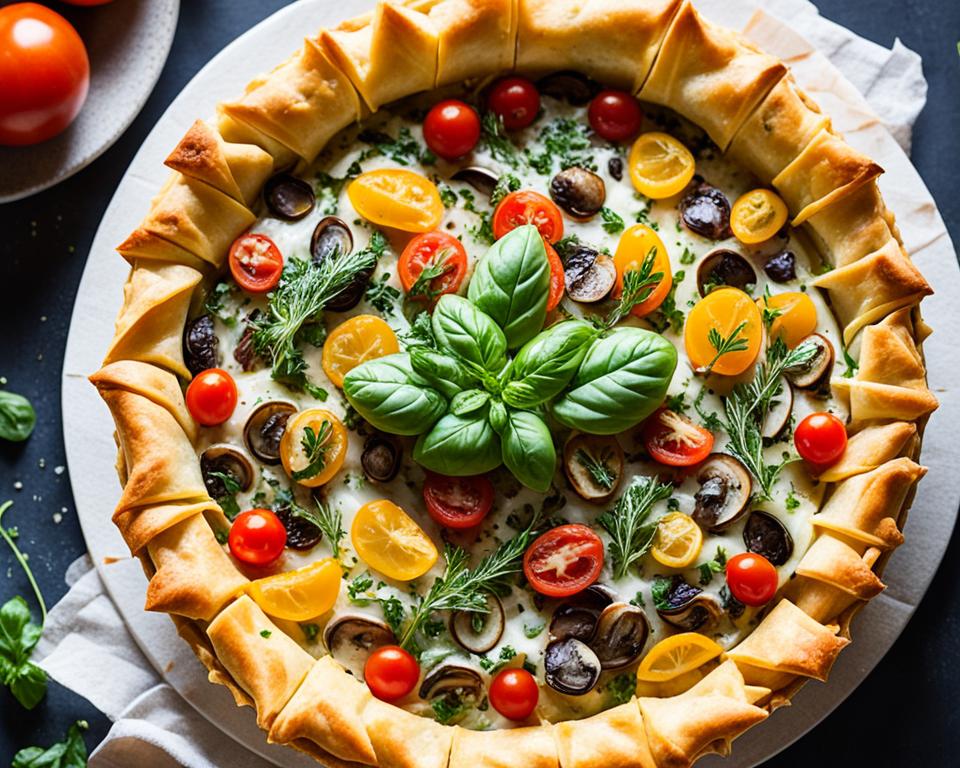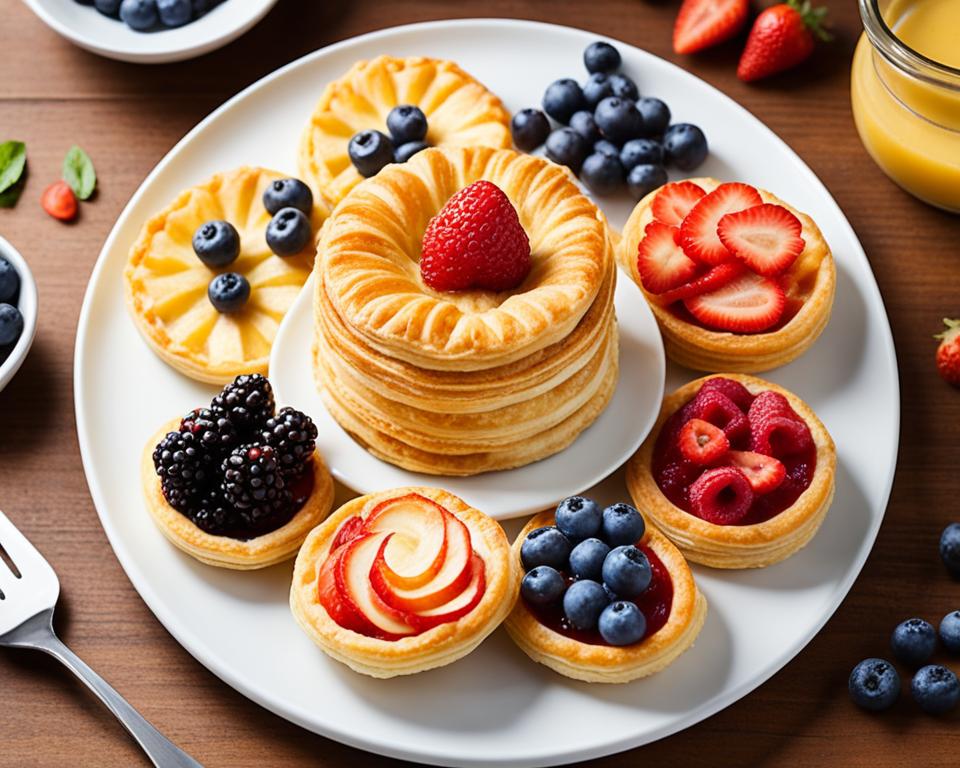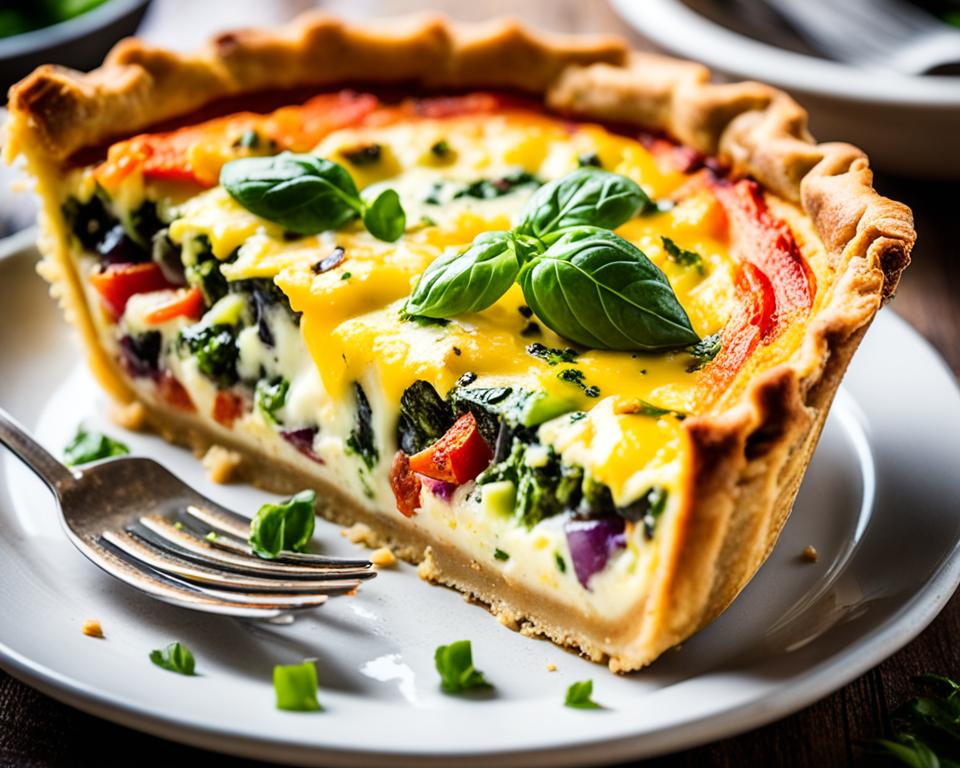Are you a gluten-free baker searching for the perfect flaky pastry? Look no further than gluten-free phyllo dough. With its delicate layers and delicious texture, it opens up a world of possibilities for creating delectable treats that are gluten-free and utterly satisfying. Whether you’re in the mood for a savory vegetable tart or a sweet cinnamon twist, gluten-free phyllo dough is the key to irresistible gluten-free baking.
Flaky pastries are a delight for any gluten-free baker, and now you can enjoy them too! Discover the versatility of gluten-free phyllo dough and the joy of indulging in delectable gluten-free flaky pastries. From homemade phyllo dough recipes to rolling tips and mouthwatering recipe ideas, we’ve got you covered. Join us on a culinary journey filled with delightful textures, flavors, and the excitement of gluten-free baking.
Key Takeaways:
- Gluten-free phyllo dough is the perfect ingredient for creating mouthwatering flaky pastries.
- Learn how to make your own homemade gluten-free puff pastry for that perfect Danish or vegetable tart.
- Puff pastry and phyllo dough are both popular choices for creating flaky and buttery pastries.
- Take your gluten-free baking to the next level with a homemade phyllo dough recipe.
- Master the art of rolling out gluten-free filo pastry for your apple strudels and baklavas.
Making Gluten-Free Puff Pastry
Making gluten-free puff pastry may seem daunting, but with the right recipe and ingredients, it can be easy and satisfying. Using gluten-free flour and vegan butter or dairy-free alternatives, you can create a delicious and flaky gluten-free puff pastry. Whether you’re making a Danish pastry or a classic vegetable tart, this versatile dough will give you the results you desire.
If you’re looking to create a gluten-free puff pastry masterpiece, follow these simple steps:
- Start by gathering your ingredients. You will need:
- 2 cups of gluten-free flour
- 1 teaspoon of salt
- 1 cup of cold vegan butter or dairy-free alternative
- 1/2 cup of ice-cold water
Now that you have your gluten-free puff pastry, you can use it to create a variety of delicious recipes. From savory Danish pastries filled with cheese and spinach to sweet turnovers filled with jam or fruit, the options are endless.
Remember, making gluten-free puff pastry takes a little extra time and effort, but the results are well worth it. The flaky texture and buttery flavor of homemade gluten-free puff pastry will impress even the most discerning palates.
Next, let’s explore the differences between puff pastry and phyllo dough and how to work with these versatile gluten-free options.
Understanding Puff Pastry and Phyllo Dough
When it comes to creating flaky and buttery pastries, both puff pastry and phyllo dough are popular choices. While they have their unique characteristics, they share the common goal of providing a delightful texture and taste. Let’s dive deeper into the differences between these two doughs and explore how to achieve gluten-free versions.
The Versatility of Puff Pastry
Puff pastry is renowned for its layers of butter and dough that result in a light and crispy texture. The process of making puff pastry involves rolling out a simple dough, placing butter on it, and folding the layers repeatedly to create those buttery pockets.
“Puff pastry allows for endless possibilities in the kitchen,” says Chef Amanda Smith. “You can create classic treats like croissants, Danish pastries, and savory turnovers with this versatile dough.”
The Thin and Delicate Phyllo Dough
Phyllo dough, on the other hand, is known for its incredibly thin and delicate layers that create a unique flaky texture. The dough is made by rolling the dough incredibly thin and brushing each layer with melted fat, resulting in a crisp and paper-thin crust when baked.
“Phyllo dough is a staple in Mediterranean and Middle Eastern cuisine,” explains Chef Maria Rodriguez. “It’s perfect for making dishes like baklava, spanakopita, and strudels.”
Gluten-Free Alternatives
For those following a gluten-free diet, enjoying puff pastry and phyllo dough might seem challenging. However, there are ways to create gluten-free versions of these doughs without compromising on taste and texture.
By using a combination of high-quality gluten-free flours and fats such as coconut oil or vegetable shortening, you can achieve excellent results. The key is to choose flours that mimic the desired texture and work well with other gluten-free ingredients.

Summary
Puff pastry and phyllo dough offer distinct characteristics that can elevate your baking endeavors. While puff pastry provides a light and buttery indulgence, phyllo dough offers a delicate and crispy crust. With the availability of gluten-free flours and fats, you can create gluten-free versions of these beloved doughs and explore a wide range of recipes.
Homemade Gluten-Free Phyllo Dough Recipe
If you’re looking for an authentic gluten-free phyllo dough experience, making your own is possible. While it requires time and effort, the results are worth it. By using a combination of gluten-free flour, psyllium husk, and other ingredients, you can create a buttery and flaky gluten-free phyllo dough. This homemade dough can be used to make a variety of delicious treats, from baklava to spanakopita.
Why Make Your Own Gluten-Free Phyllo Dough?
Making your own gluten-free phyllo dough gives you full control over the ingredients, ensuring that it aligns with your dietary needs and preferences. Store-bought options may not provide the same level of freshness and taste as homemade dough. By dedicating the time and effort to make your own, you can enjoy the authentic flavors and textures of gluten-free pastries.
“Homemade gluten-free phyllo dough allows you to customize the recipe to suit your taste and ensure the best results in your baking.” – Gluten-Free Baking Enthusiast
The Key Ingredients for Gluten-Free Phyllo Dough
Creating homemade gluten-free phyllo dough requires a combination of gluten-free flour, psyllium husk, and other ingredients. The gluten-free flour blend should consist of a mix of flours, such as rice flour, tapioca flour, and potato starch, to achieve the desired texture. Psyllium husk acts as a binder, providing structure to the dough without the need for gluten.
| Ingredients: | Quantity: |
|---|---|
| Gluten-Free Flour Blend | 2 cups |
| Psyllium Husk | 2 tablespoons |
| Olive Oil | 2 tablespoons |
| Water | 1 cup |
| Salt | 1/2 teaspoon |
Note: Feel free to experiment with different gluten-free flour blends based on your preference and dietary needs.
The Step-by-Step Process
- In a large mixing bowl, combine the gluten-free flour blend, psyllium husk, and salt.
- Add the olive oil and water to the dry mixture, and mix well until a dough forms.
- Knead the dough on a lightly floured surface until it becomes smooth and elastic.
- Divide the dough into smaller portions and cover them with a damp cloth to prevent drying.
- Roll out each portion of the dough into thin, paper-like sheets using a rolling pin.
- Layer the sheets on top of each other, brushing with olive oil between each layer.
- Use the homemade gluten-free phyllo dough to create your desired pastries, such as baklava or spanakopita.
Enjoy the satisfaction of creating your own gluten-free phyllo dough and indulge in the delicious pastries you can make with it.
Tips for Rolling Out Filo Pastry
Rolling out filo pastry requires precision and technique. To achieve the paper-thin texture, it’s important to use a thin rolling pin and keep the dough well-floured to prevent sticking. Rolling from the center outward and using plastic wrap can help with the process.
Here are some tips for rolling out gluten-free filo pastry:
- Use a thin rolling pin: A thin rolling pin will allow you to apply even pressure and achieve the desired thinness of the pastry.
- Keep the dough well-floured: Sprinkle flour on both sides of the dough and on the rolling pin to prevent sticking. This will make it easier to roll out the pastry without tearing.
- Roll from the center outward: Start rolling from the center of the dough and work your way outward. This will help to distribute the pressure evenly and create an even thickness throughout the pastry.
- Use plastic wrap: Place a sheet of plastic wrap on the work surface before rolling out the dough. This will prevent the dough from sticking to the surface and make it easier to transfer to a baking sheet.
It’s important to take your time and be patient when rolling out filo pastry. The delicate nature of the dough requires gentle handling to avoid tearing or uneven thickness. By following these tips, you’ll be able to create perfectly rolled gluten-free filo pastry, which is ideal for making delicious treats like gluten-free strudel or baklava.
| Benefits of Proper Rolling Techniques | Challenges to Overcome |
|---|---|
| Thin and flaky pastry | Dough sticking to the rolling pin |
| Even distribution of layers | Uneven thickness of the pastry |
| Easier handling and transfer | Tearing or ripping of the dough |
Gluten-Free Phyllo Dough vs. Store-Bought Options
When it comes to gluten-free baking, having the right ingredients is crucial. In the case of phyllo dough, you have the option of either making your own or opting for store-bought varieties. Let’s explore the differences between the two and why making your own gluten-free phyllo dough may be worth the effort.
The Benefits of Making Your Own Gluten-Free Phyllo Dough
Making your own gluten-free phyllo dough allows you to have complete control over the ingredients and achieve the desired texture. Gluten-free store-bought options can sometimes be drier and less flexible, compromising the overall quality of your finished pastries.
“By taking the time to make your own gluten-free phyllo dough, you can enjoy a more authentic and satisfying phyllo dough experience.”
Homemade gluten-free phyllo dough offers a lighter, crispier, and flakier texture that is essential to traditional phyllo-based recipes. The secret lies in using high-quality gluten-free flours and the right combination of fats to achieve that perfect balance.
Comparison Table: Gluten-Free Phyllo Dough vs. Store-Bought Options
| Aspect | Homemade Gluten-Free Phyllo Dough | Store-Bought Phyllo Dough |
|---|---|---|
| Texture | Light, crisp, and flaky | Potentially drier and less flexible |
| Ingredients | Control over quality and customization | Purchased and pre-packaged |
| Taste | Fresher and more flavorful | May lack homemade freshness |
| Flexibility | Modifiable for specific dietary needs and preferences | Limited options with pre-packaged dough |
As demonstrated in the table above, making your own gluten-free phyllo dough offers a range of advantages over store-bought options. From superior texture and taste to the ability to customize ingredients and cater to specific dietary needs, homemade dough provides a more authentic and satisfying baking experience.
With a homemade gluten-free phyllo dough, you can elevate your baking creations to new heights. Whether you’re crafting a delicious spanakopita or a mouthwatering baklava, the flaky and delicate nature of homemade phyllo dough will take your recipes to the next level.
Stay tuned for the next section, where we’ll explore tips and techniques for storing and freezing gluten-free phyllo dough, ensuring that you’re always prepared to whip up delicious pastries.
Storing and Freezing Gluten-Free Phyllo Dough
After making your homemade gluten-free phyllo dough, it’s essential to store it properly to preserve its freshness and texture. Whether you plan to use it within a week or want to extend its shelf life, there are specific storage methods that you can follow.
Storing Gluten-Free Phyllo Dough
If you anticipate using the gluten-free phyllo dough within a week, the best way to store it is in the refrigerator. Follow these simple steps:
- Gently wrap the dough in plastic wrap, ensuring it is well-covered.
- Place the wrapped dough in an airtight container to prevent air exposure.
- Store the container in the refrigerator, away from any strong odors or foods that may transfer flavors.
By storing the dough in the refrigerator, you can maintain its freshness and ensure it is ready to use whenever you’re craving flaky gluten-free treats.
Freezing Phyllo Dough
If you wish to extend the shelf life of your gluten-free phyllo dough, freezing is a great option. Follow these steps to freeze the dough:
- Divide the dough into manageable portions, depending on your future needs.
- Place each portion of the dough between sheets of cling film wrap.
- Gently roll and press the dough to remove any air bubbles and ensure it is evenly wrapped.
- Transfer the wrapped dough portions into an airtight container.
- Label the container with the date of freezing, ensuring you can track its freshness.
- Store the container in the freezer, where the dough will remain fresh for up to two months.
When you’re ready to use the frozen phyllo dough, simply thaw it in the refrigerator overnight before proceeding with your desired recipe. Avoid thawing the dough at room temperature to maintain its texture and prevent it from becoming soggy.
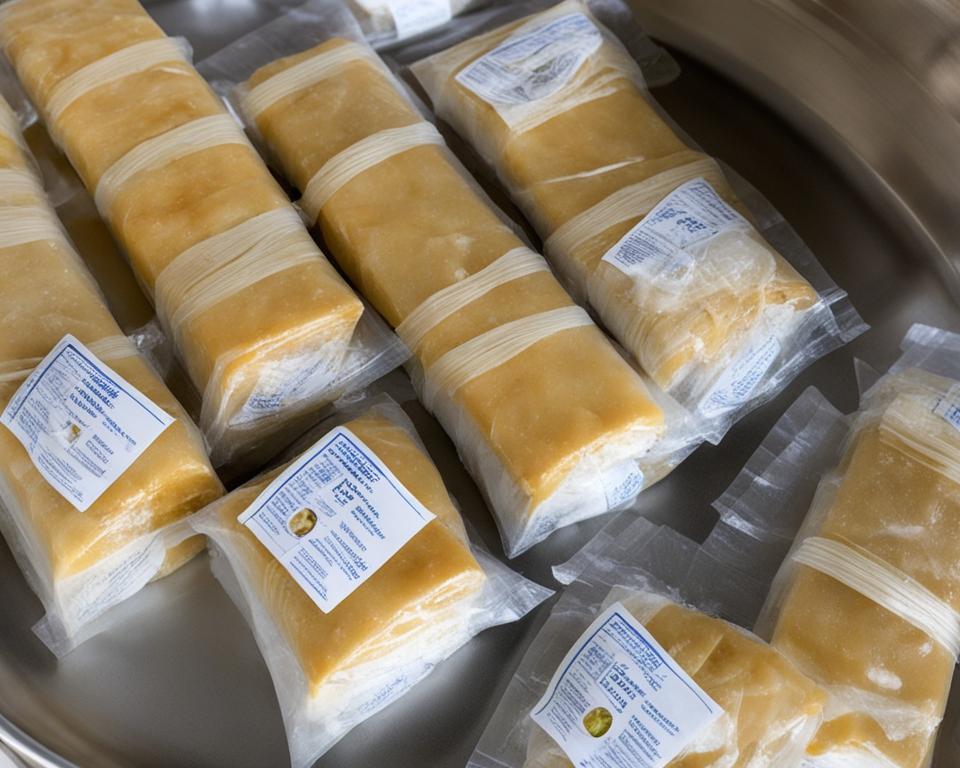
Properly storing and freezing your homemade gluten-free phyllo dough allows you to enjoy the convenience of having it readily available for your culinary endeavors. Whether you choose to keep it in the refrigerator for immediate use or freeze it for future creations, these storage methods will help maintain the quality and integrity of your gluten-free phyllo dough.
Gluten-Free Phyllo Dough Recipes
Once you have your homemade gluten-free phyllo dough, the possibilities for delicious recipes are endless. You can use it to make traditional Greek treats like Gluten-Free Baklava and Gluten-Free Spanakopita, or create sweet treats like Gluten-Free Apple Strudel. The light and flaky texture of gluten-free phyllo dough brings these recipes to life, allowing you to indulge in the flavors you love without the gluten.
Baklava Recipe
Indulge in the exquisite flavors of honey, nuts, and spices with this delightful Gluten-Free Baklava recipe. Layered with buttery gluten-free phyllo dough and a rich nut filling, it’s a sweet treat that is sure to impress. Whether you enjoy it as a dessert or a special treat with your coffee, this baklava recipe will transport you to the sun-soaked Mediterranean.
Spanakopita Recipe
Experience the savory flavors of Greece with this mouthwatering Gluten-Free Spanakopita recipe. Combining spinach, feta cheese, and herbs, this traditional dish is encased in layers of gluten-free phyllo dough, resulting in a crisp and delicious pastry. Enjoy it as an appetizer, side dish, or a delightful main course paired with a fresh salad.
Apple Strudel Recipe
Satisfy your sweet tooth with a heavenly slice of Gluten-Free Apple Strudel. Made with thinly sliced apples, warm spices, and a flaky gluten-free phyllo dough, this classic dessert is a perfect combination of tart and sweet. Serve it warm with a scoop of vanilla ice cream for a truly delectable treat.
Flaky Gluten-Free Phyllo Dough Recipes
Gluten-free phyllo dough opens up a world of possibilities for creating flaky and delicious recipes. Whether you’re in the mood for a savory dish or a sweet treat, this versatile ingredient will elevate your gluten-free baking to new heights. The light and crispy texture of gluten-free phyllo dough adds a delightful crunch to your recipes, making it an excellent choice for creating flaky crusts and desserts.
Savory Delights with Gluten-Free Phyllo Dough
Get ready to tantalize your taste buds with savory dishes made with gluten-free phyllo dough. From vegetable tarts to brie en croute, the possibilities are endless. The delicate layers of phyllo dough provide the perfect base for holding flavorful fillings, creating a harmony of textures that will impress your guests. Whether you’re hosting a dinner party or a casual gathering, these savory recipes will delight every palate.
“Gluten-free phyllo dough adds a beautiful flaky texture to my vegetable tart. The layers of crispy dough hold the savory filling together, creating a dish that bursts with flavor.” – Jane, Home Cook
| Recipe | Description |
|---|---|
| Spinach and Feta Pie | A classic Greek dish filled with a savory mixture of spinach, feta cheese, and herbs, all wrapped in flaky gluten-free phyllo dough. |
| Brie en Croute | A decadent appetizer featuring creamy brie cheese enveloped in gluten-free phyllo dough and baked to golden perfection. |
| Roasted Vegetable Tart | A medley of colorful roasted vegetables nestled in a gluten-free phyllo crust, creating a visually stunning and flavorful dish. |
Sweet Indulgences with Gluten-Free Phyllo Dough
Why should gluten-free desserts compromise on taste and texture? With gluten-free phyllo dough, you can create delightful sweet treats that are sure to impress. From classic apple strudels to heavenly cream puffs, these desserts will satisfy even the most discerning of palates. Indulge in the flaky goodness of gluten-free phyllo dough and elevate your dessert game.
“Gluten-Free phyllo dough gives my cinnamon twists the perfect flaky texture. Each bite reveals layers of fragrant cinnamon, making them a favorite in my household.” – Sarah, Home Baker
| Recipe | Description |
|---|---|
| Apple Strudel | A classic dessert featuring a luscious apple filling enveloped in layers of gluten-free phyllo dough, perfect for a sweet indulgence. |
| Cream Puffs | Delicate pastries filled with a light and creamy gluten-free vanilla filling, topped with a dusting of powdered sugar for an elegant touch. |
| Cinnamon Twists | A delectable treat made by twisting strips of gluten-free phyllo dough coated in cinnamon-sugar and baked until golden and crispy. |
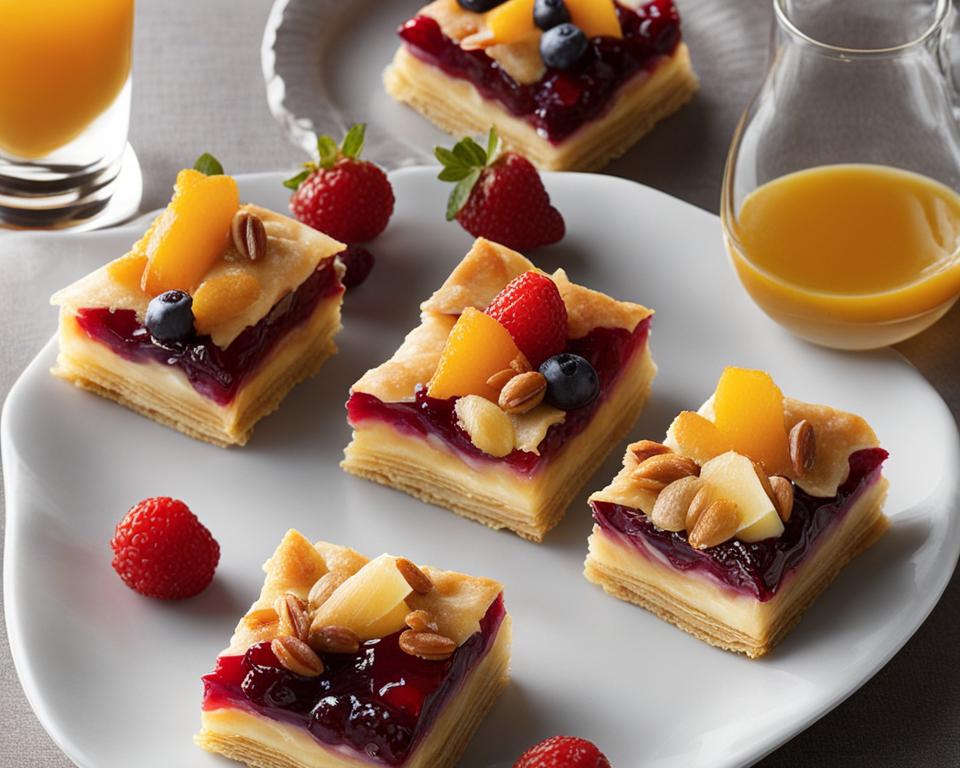
With these flaky gluten-free phyllo dough recipes, you can enjoy the best of both worlds – delicious treats that are gluten-free and full of flavor. Whether you’re a seasoned baker or just starting your gluten-free culinary journey, these recipes will inspire you to create magical moments in the kitchen. So, go ahead and explore the endless possibilities that gluten-free phyllo dough has to offer.
Conclusion
Savor the delight of gluten-free phyllo dough and indulge in the world of flaky recipes. With a homemade phyllo dough recipe and the right techniques for rolling and handling the dough, you can create mouthwatering pastries that everyone can enjoy. Whether you’re an experienced gluten-free baker or just starting out, working with gluten-free phyllo dough opens up a whole new world of culinary possibilities.
Experiment with traditional Greek treats like baklava and spanakopita, or get creative with sweet desserts like apple strudel and cream puffs. The light and crispy texture of gluten-free phyllo dough adds a delightful touch to any dish. With its versatile nature, gluten-free phyllo dough is the perfect choice for all your gluten-free baking needs.
So, roll up your sleeves, follow the steps, and let your creativity shine in the kitchen. Enjoy the pleasure of creating delicious and flaky recipes with gluten-free phyllo dough. With every bite, savor the satisfaction of gluten-free baking at its best.
FAQ
What can I make with gluten-free phyllo dough?
You can make a variety of delicious flaky recipes, both savory and sweet, such as vegetable tarts, cinnamon twists, baklava, and spanakopita.
How can I make gluten-free puff pastry?
To make gluten-free puff pastry, you can use gluten-free flour and vegan butter or dairy-free alternatives. There are various recipes available to guide you through the process.
What is the difference between puff pastry and phyllo dough?
Puff pastry is made by layering butter and dough, while phyllo dough is known for its paper-thin layers. Both can be made gluten-free with the right combination of flours and fats.
Can I make my own gluten-free phyllo dough?
Yes, it is possible to make your own gluten-free phyllo dough by using a combination of gluten-free flour, psyllium husk, and other ingredients. It requires time and effort, but the results are worth it.
What are some tips for rolling out filo pastry?
To achieve the paper-thin texture of filo pastry, use a thin rolling pin and keep the dough well-floured to prevent sticking. Rolling from the center outward and using plastic wrap can also help with the process.
Should I buy store-bought gluten-free phyllo dough or make my own?
While store-bought options are available, making your own gluten-free phyllo dough allows you to control the ingredients and achieve a lighter and crispier texture.
How should I store and freeze gluten-free phyllo dough?
If you plan to use it within a week, store the dough in the refrigerator. To prolong its shelf life, roll the dough in cling film wrap and store it in an airtight container in the freezer for up to two months.
What are some delicious gluten-free phyllo dough recipes?
Some popular gluten-free phyllo dough recipes include baklava, spanakopita, and apple strudel. The light and flaky texture of the dough enhances the flavors of these sweet and savory treats.
What can I make with gluten-free phyllo dough besides pastries?
You can use gluten-free phyllo dough to create flaky crusts for pies and tarts, as well as delicious desserts like cream puffs and brie en croute.
Are there any tips for working with gluten-free phyllo dough?
Some tips for working with gluten-free phyllo dough include handling it gently, keeping it well-floured, and working quickly to prevent the dough from drying out.
What are the benefits of using gluten-free phyllo dough?
Using gluten-free phyllo dough allows individuals with gluten sensitivities or dietary restrictions to enjoy flaky and delicious pastries without compromising on texture or taste.

